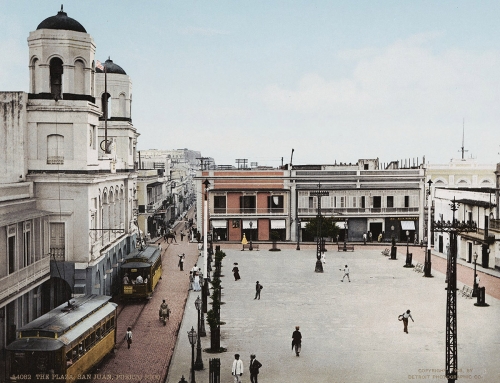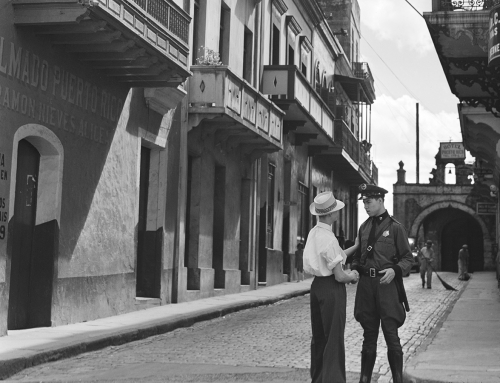Serie de 25 fotos de Puerto Rico a color que aparecen en el libro The Commonwealth of Puerto Rico por Earl Parker Hanson (1899-1978), preparado con la cooperación del American Geographical Society y publicado en 1962. El libro contiene ilustraciones, mapas y fotos en blanco y negro, junto a una serie de 25 estampillas a color diseñadas para ser recortadas y pegadas en varios lugares indicados numéricamente en las páginas del libro.
En el libro se resaltan los beneficios del proyecto de modernización de Puerto Rico bajo el gobierno estadounidense y el proyecto de industrialización de la isla promovido desde 1940 por Luis Muñoz Marín (1898-1980). Según el autor del libro:
For centuries after the first settlement, Puerto Rico remained a poor, rather sleepy Spanish colony, producing little wealth, either for the crown or for its own inhabitants, living largely by smuggling to and from the North American British colonies and their succeeding United States. In 1898, as a result of the Spanish American War, Puerto Rico was ceded by Spain to the United States, and so began its modern period. American ways of living and doing things began to meet, and mingle with, old Spanish ways.
[…]
However, the island’s significance by now reaches far beyond its unique position in inter-American affairs. Its people have embarked energetically on a new way of life, with new ways of doing things and thinking about things, and these ways are being copied and studied by other people all over the world.
From 1898 until 1940, Puerto Rico was a blighted land; thousands of its people were permanently unemployed and had no land on which to grow food; other thousands were paid such low wages that a good life was impossible; hunger and actual starvation, as well as much disease, were the results.
Then, in 1940, the people elected to political power a new leader, Luis Munoz Marín, first as President of the Senate, and later, since 1948, as governor, reelected in 1952, 1956, and 1960.
He and his co-workers in the government have stirred the people to have new faith in themselves, new hopes for the future, and to work very hard toward attaining that future. They have also won the confidence of the United States. Both the United States government and the American business world are today doing everything possible to help the Puerto Ricans to help themselves out of their old life of misery. The results, in higher income, more jobs, improved health and education for the people of Puerto Rico, have been so dramatic that many people find it difficult to believe the official statistics.
About 1950, word began to get around that something startling was happening on this Caribbean island under the American flag. Official observers and students began to go to Puerto Rico, first in small numbers and largely from Latin America, but then, in an ever-swelling stream ‘ from Asia, Africa and the Pacific world as well. By 1962 more than 14,000 such visitors had been to Puerto Rico, sent by their own governments or sponsored by the United States, the Puerto Rican government, or the United Nations. Today they are going there at a rate of almost 1,500 per year, from virtually all the free world’s “underdeveloped” areas.
Las 25 estampillas fotográficas a color
Reproducimos a continuación las 25 estampillas a color del libro junto al texto descriptivo de cada una.



Portadas y muestra de algunas páginas del libro

Portadas del libro The Commonwealth of Puerto Rico.

Interior del libro en donde vemos a mano izquierda las estampillas fotográficas a color.

Hoja con las 25 estampillas fotográficas a color.

El libro resalta los beneficios del proyecto de industrialización de Puerto Rico impulsado por Luis Muñoz Marín desde 1940. Observe el recuadro reservado para pegar la laminilla fotográfica a color, que tiene al centro el texto Plate 24.

Mapa de Puerto Rico que muestra las principales industrias de la isla en 1962.

Páginas interiores del libro en donde se indica el lugar para pegar las estampillas fotográficas (donde lee Plate 1 y Plate 9).
Sobre el autor del libro
En el libro aparece una breve biografía del autor Earl Parker Hanson que reproducimos a continuación. Observe que el autor vivió en Puerto Rico, fue consultor para el Departamento de Estado del gobierno de la isla y publicó varios libros sobre Puerto Rico.
ENGINEER, explorer, geographer, and author, Earl Parker Hanson has worked in many countries of Latin America, Africa, and the sub-arctic. In 1935-36 he began the work of economic planning in Puerto Rico. From 1949 to 1956 he was Professor of Geography and Chairman of the Department of Geography and Geology, at the University of Delaware. He now lives in Puerto Rico, where he is a consultant in the Commonwealth’s Department of State. Among his latest books are two about Puerto Rico: Transformation, The Story of Modern Puerto Rico; and Puerto Rico: Land of Wonders.
En la página web del Dartmouth College Library aparece una biografía más completa del autor:
Hanson, Earl Parker, 1899-1978
Earl Parker Hanson was born in Germany in 1899. He received his B.S. degree in 1922, from the University of Wisconsin. After graduation he spent three years in the Atacama Desert of Chile doing engineering and construction work as well as independent research in geography and archeology. In 1927, he went to Iceland as an engineer and investigator, doing reconnaissance work toward rural electrification on the island of Sagas, and studying possibilities for the Greenland-Iceland flying route to Europe. In 1929, he was sent to sub-arctic Canada to study pioneer movements in Canada’s northward expansion. From 1931-1933, Hanson traveled through the jungles of South America, the Amazon Basins and the Andes of Peru, Ecuador and Colombia making a scientific survey for the Carnegie Institute of Washington. In 1935, the National Resource Committee sent him to Puerto Rico as planning consultant on loan to the Puerto Rico Reconstruction Administration. Hanson resigned from the government in early 1937. He died in 1978.
Fuente: Libro The Commonwealth of Puerto Rico por Earl Parker Hanson, preparado con la cooperación del American Geographical Society y publicado por Nelson Doubleday, Inc., Garden City, N.Y. en 1962. Parte de la colección GeoIsla.

































You must be logged in to post a comment.